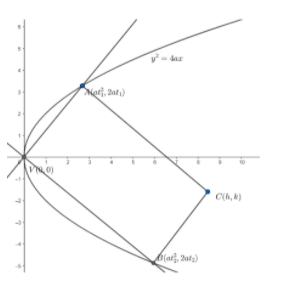
If from the vertex of a parabola, a pair of chords be drawn at right angles to one another and with these chords as adjacent sides a rectangle be made, prove that the locus of the further angle of the rectangle is the parabola \[{{y}^{2}}=4a\left( x-8a \right)\].
Answer
142.2k+ views
Hint: The mid-points of the diagonals of a rectangle are the same .
Let’s take the equation of parabola as \[{{y}^{2}}=4ax\].
We know the vertex of this parabola is at \[V\left( 0,0 \right)\].
Let \[A\left( at_{1}^{2},2a{{t}_{1}} \right)\] and \[B\left( at_{2}^{2},2a{{t}_{2}} \right)\] be the two vertices of the rectangle.

Now, we are given that the two chords are perpendicular.
We know that if two lines are perpendicular to each other , then the product of their slopes is equal to \[-1\].
So, slope of \[VA\times \] slope of \[VB=-1\]
Now , we will find the slope of \[VA\] and slope of \[VB\].
We know , the slope of the line joining two points \[({{x}_{1}},{{y}_{1}})\] and \[({{x}_{2}},{{y}_{2}})\] is given as \[m=\dfrac{{{y}_{2}}-{{y}_{1}}}{{{x}_{2}}-{{x}_{1}}}\].
So , slope of \[VA=\dfrac{2a{{t}_{1}}-0}{at_{1}^{2}-0}=\dfrac{2}{{{t}_{1}}}\]
And , slope of \[\text{ }VB=\dfrac{2a{{t}_{2}}-0}{at_{2}^{2}-0}=\dfrac{2}{{{t}_{2}}}\]
So, \[\dfrac{2}{{{t}_{1}}}\times \dfrac{2}{{{t}_{2}}}=-1\]
\[\Rightarrow {{t}_{1}}{{t}_{2}}=-4....\left( i \right)\]
We need to find the locus of further vertex.
So , we will consider the further vertex to be \[C\left( h,k \right)\].
Now , in the question it is given that \[AVBC\] is a rectangle.
We know the diagonals of a rectangle bisect each other.
So , midpoint of \[AB=\] midpoint of \[\text{ }VC.....(ii)\]
Now, we will find the midpoints of \[AB\] and \[VC\].
Midpoint of
\[\text{ }AB=\left( \dfrac{at_{1}^{2}+at_{2}^{2}}{2},\dfrac{2a{{t}_{1}}+2a{{t}_{2}}}{2} \right)\]
\[=\left( \dfrac{at_{1}^{2}+at_{2}^{2}}{2},a{{t}_{1}}+a{{t}_{2}} \right)....\left( iii \right)\]
Midpoint of \[\text{ VC}=\left( \dfrac{h+0}{2},\dfrac{k+0}{2} \right)\]
\[=\left( \dfrac{h}{2},\dfrac{k}{2} \right).....\left( iv \right)\]
From \[\left( ii \right),\left( iii \right)\]and \[\left( iv \right)\], we can say
\[\dfrac{h}{2}=\dfrac{at_{1}^{2}+at_{2}^{2}}{2}\] and \[\dfrac{k}{2}=a{{t}_{1}}+a{{t}_{2}}\]
Now, \[\dfrac{h}{2}=\dfrac{at_{1}^{2}+at_{2}^{2}}{2}\]
\[\Rightarrow t_{1}^{2}+t_{2}^{2}=\dfrac{h}{a}....\left( v \right)\]
and \[\dfrac{k}{2}=\left( a{{t}_{1}}+a{{t}_{2}} \right)\]
\[\Rightarrow {{t}_{1}}+{{t}_{2}}=\dfrac{k}{2a}.....\left( vi \right)\]
Squaring both sides we get
\[t_{1}^{2}+t_{2}^{2}+2{{t}_{1}}{{t}_{2}}=\dfrac{{{k}^{2}}}{4{{a}^{2}}}.....\left( vii \right)\]
From equation \[\left( i \right),\left( v \right)\]and \[\left( vii \right)\]
\[\dfrac{h}{a}-8=\dfrac{{{k}^{2}}}{4{{a}^{2}}}\]
or \[{{k}^{2}}=4a\left( h-8a \right)\]…….equation\[(viii)\]
Now, to find the locus of \[C\left( h,k \right)\], we will substitute \[(x,y)\] in place of \[\left( h,k \right)\] in equation \[(viii)\]
So, the locus of \[C\left( h,k \right)\] is given as \[{{y}^{2}}=4a\left( x-8a \right)\]
Note: While simplifying the equations , please make sure that sign mistakes do not occur. These mistakes are very common and can cause confusions while solving. Ultimately the answer becomes wrong. So, sign conventions should be carefully taken .
Let’s take the equation of parabola as \[{{y}^{2}}=4ax\].
We know the vertex of this parabola is at \[V\left( 0,0 \right)\].
Let \[A\left( at_{1}^{2},2a{{t}_{1}} \right)\] and \[B\left( at_{2}^{2},2a{{t}_{2}} \right)\] be the two vertices of the rectangle.

Now, we are given that the two chords are perpendicular.
We know that if two lines are perpendicular to each other , then the product of their slopes is equal to \[-1\].
So, slope of \[VA\times \] slope of \[VB=-1\]
Now , we will find the slope of \[VA\] and slope of \[VB\].
We know , the slope of the line joining two points \[({{x}_{1}},{{y}_{1}})\] and \[({{x}_{2}},{{y}_{2}})\] is given as \[m=\dfrac{{{y}_{2}}-{{y}_{1}}}{{{x}_{2}}-{{x}_{1}}}\].
So , slope of \[VA=\dfrac{2a{{t}_{1}}-0}{at_{1}^{2}-0}=\dfrac{2}{{{t}_{1}}}\]
And , slope of \[\text{ }VB=\dfrac{2a{{t}_{2}}-0}{at_{2}^{2}-0}=\dfrac{2}{{{t}_{2}}}\]
So, \[\dfrac{2}{{{t}_{1}}}\times \dfrac{2}{{{t}_{2}}}=-1\]
\[\Rightarrow {{t}_{1}}{{t}_{2}}=-4....\left( i \right)\]
We need to find the locus of further vertex.
So , we will consider the further vertex to be \[C\left( h,k \right)\].
Now , in the question it is given that \[AVBC\] is a rectangle.
We know the diagonals of a rectangle bisect each other.
So , midpoint of \[AB=\] midpoint of \[\text{ }VC.....(ii)\]
Now, we will find the midpoints of \[AB\] and \[VC\].
Midpoint of
\[\text{ }AB=\left( \dfrac{at_{1}^{2}+at_{2}^{2}}{2},\dfrac{2a{{t}_{1}}+2a{{t}_{2}}}{2} \right)\]
\[=\left( \dfrac{at_{1}^{2}+at_{2}^{2}}{2},a{{t}_{1}}+a{{t}_{2}} \right)....\left( iii \right)\]
Midpoint of \[\text{ VC}=\left( \dfrac{h+0}{2},\dfrac{k+0}{2} \right)\]
\[=\left( \dfrac{h}{2},\dfrac{k}{2} \right).....\left( iv \right)\]
From \[\left( ii \right),\left( iii \right)\]and \[\left( iv \right)\], we can say
\[\dfrac{h}{2}=\dfrac{at_{1}^{2}+at_{2}^{2}}{2}\] and \[\dfrac{k}{2}=a{{t}_{1}}+a{{t}_{2}}\]
Now, \[\dfrac{h}{2}=\dfrac{at_{1}^{2}+at_{2}^{2}}{2}\]
\[\Rightarrow t_{1}^{2}+t_{2}^{2}=\dfrac{h}{a}....\left( v \right)\]
and \[\dfrac{k}{2}=\left( a{{t}_{1}}+a{{t}_{2}} \right)\]
\[\Rightarrow {{t}_{1}}+{{t}_{2}}=\dfrac{k}{2a}.....\left( vi \right)\]
Squaring both sides we get
\[t_{1}^{2}+t_{2}^{2}+2{{t}_{1}}{{t}_{2}}=\dfrac{{{k}^{2}}}{4{{a}^{2}}}.....\left( vii \right)\]
From equation \[\left( i \right),\left( v \right)\]and \[\left( vii \right)\]
\[\dfrac{h}{a}-8=\dfrac{{{k}^{2}}}{4{{a}^{2}}}\]
or \[{{k}^{2}}=4a\left( h-8a \right)\]…….equation\[(viii)\]
Now, to find the locus of \[C\left( h,k \right)\], we will substitute \[(x,y)\] in place of \[\left( h,k \right)\] in equation \[(viii)\]
So, the locus of \[C\left( h,k \right)\] is given as \[{{y}^{2}}=4a\left( x-8a \right)\]
Note: While simplifying the equations , please make sure that sign mistakes do not occur. These mistakes are very common and can cause confusions while solving. Ultimately the answer becomes wrong. So, sign conventions should be carefully taken .
Recently Updated Pages
Difference Between Mutually Exclusive and Independent Events

Difference Between Area and Volume

JEE Main Participating Colleges 2024 - A Complete List of Top Colleges

JEE Main Maths Paper Pattern 2025 – Marking, Sections & Tips

Sign up for JEE Main 2025 Live Classes - Vedantu

JEE Main 2025 Helpline Numbers - Center Contact, Phone Number, Address

Trending doubts
JEE Main 2025 Session 2: Application Form (Out), Exam Dates (Released), Eligibility, & More

JEE Main Exam Marking Scheme: Detailed Breakdown of Marks and Negative Marking

JEE Main 2025: Derivation of Equation of Trajectory in Physics

Electric Field Due to Uniformly Charged Ring for JEE Main 2025 - Formula and Derivation

Learn About Angle Of Deviation In Prism: JEE Main Physics 2025

Degree of Dissociation and Its Formula With Solved Example for JEE

Other Pages
JEE Advanced Marks vs Ranks 2025: Understanding Category-wise Qualifying Marks and Previous Year Cut-offs

JEE Advanced 2025: Dates, Registration, Syllabus, Eligibility Criteria and More

JEE Advanced Weightage 2025 Chapter-Wise for Physics, Maths and Chemistry

JEE Main 2025: Conversion of Galvanometer Into Ammeter And Voltmeter in Physics

Electron Gain Enthalpy and Electron Affinity for JEE

Electrical Field of Charged Spherical Shell - JEE




